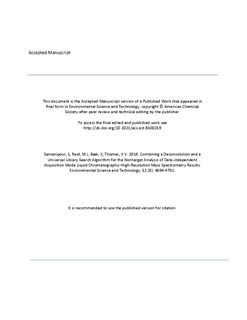| dc.contributor.author | Samanipour, Saer | |
| dc.contributor.author | Reid, Malcolm James | |
| dc.contributor.author | Bæk, Kine | |
| dc.contributor.author | Thomas, Kevin V | |
| dc.date.accessioned | 2019-05-29T13:42:32Z | |
| dc.date.available | 2019-05-29T13:42:32Z | |
| dc.date.created | 2018-11-22T11:35:49Z | |
| dc.date.issued | 2018 | |
| dc.identifier.citation | Environmental Science and Technology. 2018, 52 (8), 4694-4701. | nb_NO |
| dc.identifier.issn | 0013-936X | |
| dc.identifier.uri | http://hdl.handle.net/11250/2599474 | |
| dc.description.abstract | Nontarget analysis is considered one of the most comprehensive tools for the identification of unknown compounds in a complex sample analyzed via liquid chromatography coupled to high-resolution mass spectrometry (LC–HRMS). Due to the complexity of the data generated via LC–HRMS, the data-dependent acquisition mode, which produces the MS2 spectra of a limited number of the precursor ions, has been one of the most common approaches used during nontarget screening. However, data-independent acquisition mode produces highly complex spectra that require proper deconvolution and library search algorithms. We have developed a deconvolution algorithm and a universal library search algorithm (ULSA) for the analysis of complex spectra generated via data-independent acquisition. These algorithms were validated and tested using both semisynthetic and real environmental data. A total of 6000 randomly selected spectra from MassBank were introduced across the total ion chromatograms of 15 sludge extracts at three levels of background complexity for the validation of the algorithms via semisynthetic data. The deconvolution algorithm successfully extracted more than 60% of the added ions in the analytical signal for 95% of processed spectra (i.e., 3 complexity levels multiplied by 6000 spectra). The ULSA ranked the correct spectra among the top three for more than 95% of cases. We further tested the algorithms with 5 wastewater effluent extracts for 59 artificial unknown analytes (i.e., their presence or absence was confirmed via target analysis). These algorithms did not produce any cases of false identifications while correctly identifying ∼70% of the total inquiries. The implications, capabilities, and the limitations of both algorithms are further discussed. | nb_NO |
| dc.language.iso | eng | nb_NO |
| dc.publisher | American Chemical Society | nb_NO |
| dc.title | Combining a Deconvolution and a Universal Library Search Algorithm for the Nontarget Analysis of Data-Independent Acquisition Mode Liquid Chromatography-High-Resolution Mass Spectrometry Results | nb_NO |
| dc.type | Journal article | nb_NO |
| dc.type | Peer reviewed | nb_NO |
| dc.description.version | acceptedVersion | nb_NO |
| dc.source.pagenumber | 4694-4701 | nb_NO |
| dc.source.volume | 52 | nb_NO |
| dc.source.journal | Environmental Science and Technology | nb_NO |
| dc.source.issue | 8 | nb_NO |
| dc.identifier.doi | 10.1021/acs.est.8b00259 | |
| dc.identifier.cristin | 1633683 | |
| dc.relation.project | Norges forskningsråd: 243720 | nb_NO |
| cristin.unitcode | 7464,30,21,0 | |
| cristin.unitname | Miljøkjemi | |
| cristin.ispublished | true | |
| cristin.fulltext | postprint | |
| cristin.qualitycode | 2 | |
